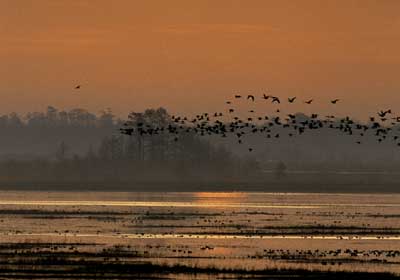
Wetland habitats may come under pressure as sea level rises due to climate change.USFWS photo by John and Karen Hollingsworth
The U.S. Fish and Wildlife Service conserves our nation’s heritage of wild things and wild places, which are threatened by forces such as habitat destruction and fragmentation, invasive species, and water scarcity.
Now, worldwide scientific consensus tells us that human activity is changing the climate system itself. As climate changes, the abundance and distribution of wildlife and fish will also change. Some species will adapt successfully to an abruptly warming world; many will struggle; and others will disappear.
The Challenge
The Intergovernmental Panel on Climate Change (IPCC) reports in their “Summary for Policymakers of the Synthesis Report of the IPCC Fourth Assessment Report” that “(w)arming of the climate system is unequivocal, as is now evident from observations of increases in global average air and ocean temperatures, widespread melting of snow and ice, and rising global average sea level.”
The IPCC has predicted impacts to natural systems due to climate change.
What species are most vulnerable to rapid changes in climate?
- Endangered and threatened species now living at the limits of survival;
- Plants and animals living within confined geographic ranges with limited abilities to move rapidly; and
- Species migrating to new areas where they meet increased competition for habitat or food.
Our Role
As the nation’s principle federal conservation agency, the U.S. Fish and Wildlife Service is dedicated to helping reduce the impacts of climate change on fish, wildlife, and their habitats. Our 8,000 employees specialize in wildlife management and ecosystem dynamics, and have an extensive network of partners who work alongside us to protect our nation’s fish and wildlife resources.
We are already working with partners and available resources to address climate change effects on wildlife. Accelerating climate change will make harder many of the conservation challenges our employees are dealing with today. We cannot meet these challenges alone.
We are also developing a climate change strategic plan. Following this plan, over the next five years we will acquire additional resources and build our organization’s capacity to address the impacts of climate change on natural systems. This capacity will enable our employees to more effectively plan, design, implement, and monitor strategic conservation efforts.
As we refine and finalize our strategic plan based on employee and partner feedback in mid-2009, we will move quickly to:
- identify and fill knowledge gaps,
- expand capability to plan and work with partners,
- identify habitats and corridors most important across landscapes, and
- engage the public in our efforts to conserve the nature of America in a changing climate.
|

